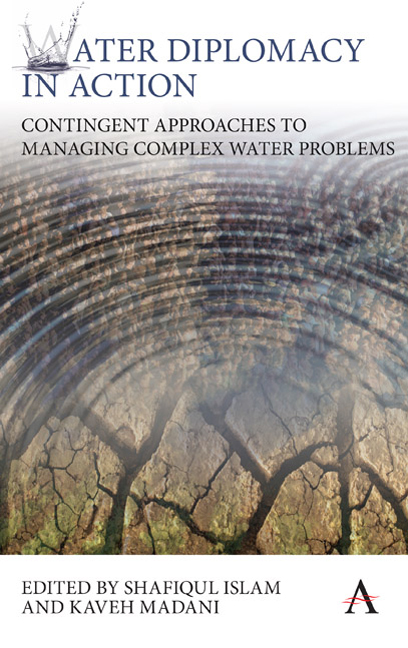Book contents
- Frontmatter
- Contents
- List of Figures
- List of Tables
- The Blind Men, the Elephant and the Well: A Parable for Complexity and Contingency
- Preface
- Part I ROOTS AND CAUSES OF COMPLEXITY AND CONTINGENCY IN WATER PROBLEMS
- Part II TOOLS, TECHNIQUES, MODELS AND ANALYSES TO RESOLVE COMPLEX WATER PROBLEMS
- Chapter Three Ten Bankruptcy Methods for Resolving Natural Resource Allocation Conflicts
- Chapter Four Flexible Design of Water Infrastructure Systems
- Chapter Five Extreme Value Analysis for Modeling Nonstationary Hydrologic Change
- Chapter Six The Water– Food Nexus and Virtual Water Trade
- Chapter Seven A Hybrid Analytical Approach for Modeling the Dynamics of Interactions for Complex Water Problems
- Chapter Eight A Call for Capacity Development for Improved Water Diplomacy
- Chapter Nine Water Complexity and Physics- Guided Data Mining
- Part III CASE STUDIES
- Notes on Contributors
- Index
Chapter Four - Flexible Design of Water Infrastructure Systems
from Part II - TOOLS, TECHNIQUES, MODELS AND ANALYSES TO RESOLVE COMPLEX WATER PROBLEMS
Published online by Cambridge University Press: 10 January 2018
- Frontmatter
- Contents
- List of Figures
- List of Tables
- The Blind Men, the Elephant and the Well: A Parable for Complexity and Contingency
- Preface
- Part I ROOTS AND CAUSES OF COMPLEXITY AND CONTINGENCY IN WATER PROBLEMS
- Part II TOOLS, TECHNIQUES, MODELS AND ANALYSES TO RESOLVE COMPLEX WATER PROBLEMS
- Chapter Three Ten Bankruptcy Methods for Resolving Natural Resource Allocation Conflicts
- Chapter Four Flexible Design of Water Infrastructure Systems
- Chapter Five Extreme Value Analysis for Modeling Nonstationary Hydrologic Change
- Chapter Six The Water– Food Nexus and Virtual Water Trade
- Chapter Seven A Hybrid Analytical Approach for Modeling the Dynamics of Interactions for Complex Water Problems
- Chapter Eight A Call for Capacity Development for Improved Water Diplomacy
- Chapter Nine Water Complexity and Physics- Guided Data Mining
- Part III CASE STUDIES
- Notes on Contributors
- Index
Summary
Abstract
Future water needs and sources of supply are often highly uncertain. This is especially the case in the many areas under stress from climate change and rapid, variable urban development. Innovations in water treatment technologies, and price volatility in energy and other resources combine to aggravate the uncertainties concerning the risks and opportunities associated with planning investments in water infrastructure systems. The problem is that conventional techniques for the planning and design of water supply systems do not adequately deal with these important uncertainties. This chapter presents “Flexible Design” as an approach to deal with the situation, and demonstrates its effectiveness in a case study, inspired by Singapore, of a long- term design of the water supply system for a major city. The results show that Flexible Design can significantly increase overall performance compared to conventional design methods— a 15 percent increase in expected present monetary value, while decreasing downside risk and increasing upside opportunities. Flexible Design achieves these improvements by carefully analyzing possible futures using Monte Carlo simulation and designing the system with modules that managers can implement as and when needed. Flexible Design is shown to be an effective tool and is increasingly used in infrastructure development.
Introduction
The future is uncertain. Technologies, needs, policies, economies, and environments change frequently. Some changes are quantifiable, and we attempt to make best estimates of what will happen, but we will always encounter game- changing events and unanticipated new technologies.
When decision-makers consider needs for future water infrastructure, they often use a conventional, deterministic approach. They assume that current conditions will not change and that we can safely rely on a forecast of long- term requirements. However, the water supply and demand system is complex. Natural, societal, and political forces interact to drive changes in both supply and demand over time. Our ability to predict future conditions is low when dealing with such complexity, leading to forecasts that are rarely accurate.
For projects in transboundary watersheds or other multi- stakeholder water systems, reaching consensus among stakeholders on highly uncertain future conditions is a key challenge; there is a tendency to downplay uncertainty to make the problem more tractable and to advocate for a vision of the future convenient to dominant interests (Lempert and Kalra 2011).
- Type
- Chapter
- Information
- Water Diplomacy in ActionContingent Approaches to Managing Complex Water Problems, pp. 51 - 74Publisher: Anthem PressPrint publication year: 2017

